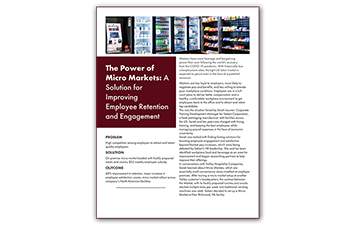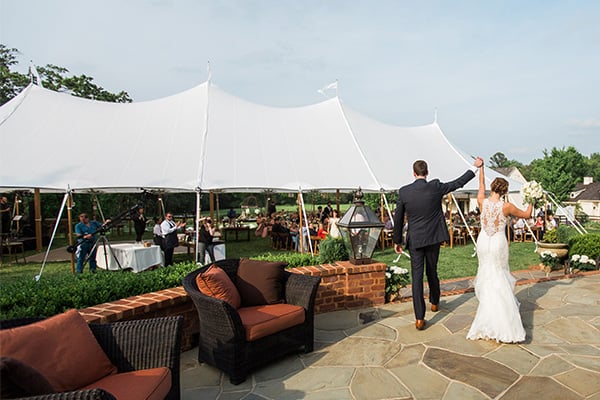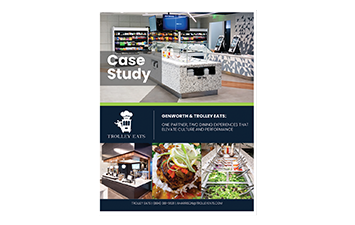The Pros and Cons of Plated, Family Style, and Buffet Meals
Weddings come in all shapes and sizes, as do the options of meal styles available. Plated, family style, and buffet meals are the most popular choices, and they each have their advantages and disadvantages. We’ve outlined the details, pros, and cons of each one to help you make the best possible decision and be one step closer to having the wedding you’ve always dreamed of.
Plated: A plated meal is a dining option in which your guests remain seated for the meal, and are served all the courses by a hired wait staff. Plated meals can be done one of two ways: guests can be given options for their entrée, or you can opt for a duet meal. Typically when options are given, two or three entrée options are included in the menu, and each of your guests choose which one they would like prior to your event. If you do decide to give your guests options, keep in mind that you will have to keep a record of who ordered what and then relay this information to your caterer. Conversely, if you choose to serve a duet meal, there will typically be a half-portion of two different meat options (chicken/beef/fish/pork) served with sides on the same plate. Duet meals are a bit less time-consuming than an optioned plated meal, as everyone will be served the same thing. For either type of plated event, three courses are generally served (soup/salad, entrée, and dessert), and this service style is most appropriate for more formal, black-tie affairs.
Pros: Being waited on can be less stressful for your guests than other service styles, namely buffet meals, because they do not have to wait in lines or get up to retrieve their food. You also will not have any wasted food with these meals, since plates are pre-portioned by a hired wait staff. Additionally, this style of service offers an air of unparallelled sophistication.
Cons: This menu will have less variety than a buffet, so it is best to serve foods that are widely appealing in order to accommodate guests with dietary restrictions. A plated meal will also take up more of your reception time, reducing the time available for ceremonial activities such as toasts, formal dances, cake-cutting and casual activities such as socializing or dancing.
Cost: Plated meals are normally the most expensive dining option because of the amount of labor required to serve the food and set the tables prior to the event. In addition to the increased cost of service staff, onsite chefs will also be necessary, further increasing the cost.
Summary: Plated meals are classy and elegant, which makes them best suited for very formal weddings. Although they are expensive and time consuming due to the amount of labor required, the upscale sophistication and elegance they contribute to your wedding is worth the extra money and time allotment.
Family Style: This type of service style has gained a lot of popularity in recent years because it is less formal than a plated meal, yet more formal than a buffet. Essentially, waiters will bring your food to the table in large serving dishes, and these will be passed around for each person to serve their own plate. If you choose to order extra food, the waiters will then refill these dishes whenever they are running low. We would suggest serving a family style meal if you are envisioning a chic, yet casual and comfortable ambiance at your reception. Since this service style is still a fairly new concept, it’s also a great option if you’re trying to do something a little bout of the ordinary.
Pros: Family style encourages your guests to interact, and it creates a warm, inviting atmosphere while still allowing them to sit back and relax at the table. Also, like a buffet, your guests can help themselves to as much or as little of each dish as they want, but keep in mind that you will need to order additional food if you'd like to ensure that everyone will be able to have seconds.
Cons: You will be passing large platters of food around a table, so family style meals definitely have the potential to get very messy.
Cost: Family style meals will be roughly the same price as a plated meal, as you will need an increased number of service staff and onsite chefs to assemble the dishes for presentation. This service style also decreases the variety of food that is typically offered, and cuts into time that could be used otherwise during your event.
Summary: Family style meals, depending on what you decide to serve, can get quite pricey, and they take up about as much time as a plated meal. They are comfortably elegant and create a cozy vibe, so they are most appropriate for weddings falling somewhere between very formal and casual. Their biggest benefit is that they combine the positive aspects of both a plated and buffet meal, offering sophistication while still allowing guests to choose their portion size.
Buffet: With buffets, food is typically presented in chafing dishes, or on ceramic or glass platters placed on banquet tables, and guests walk along either side of it to help themselves to the food. It is also an option to have staff at each dish to help serve your guests. Buffets can be scaled up or down to match the formality of your wedding, but they definitely lend a much more informal feel than plated or family style meals. They are best for informal weddings or when you are on a tighter budget.
Pros: Buffets enable you to offer your guests a large variety of food in sizable amounts. With this service style, you should not have to worry about anybody going home hungry, and unlike a plated meal, if your guests choose something they don’t particularly enjoy, they can simply get up and find something else to eat. Also, since buffets encourage guests to be mobile and walk around, they will have ample opportunities to mingle with each other. If you do not have assigned seating or are tight on space, buffets are a perfect option since not all of your guests will be seated at the same time.
Cons: This service style can sometimes get hectic if too many people go up to get food at once. Keep lines at a minimum and avoid chaos by only having a few tables get up at a time. Another problem that can be encountered is having too much or too little food. There is no portion-control implemented when guests are filling their plates, and it is hard to know how hungry each person will be. For this reason, food for a buffet typically needs to be over-ordered because it is better to have a little extra than not enough. Your caterer will help you decide exactly how much you’ll need so that you don’t end up wasting lots of food.
Cost: Since you will not need servers to wait on your guests, this service style will be your least expensive option even though everyone will be able to go back for seconds.
Summary: Buffets are very casual, the least expensive of the service styles, and they allow you to offer a wide variety of foods. Although they are less elegant than plated and family style meals, they also take up less of your reception time. So, if want to spend more time on other activities and are looking for a casual vibe, buffets are a great choice.
If you have any questions or need help planning your event, give us a call at 804.868.8900 and one of our wonderful wedding coordinators will be more than happy to assist you.













